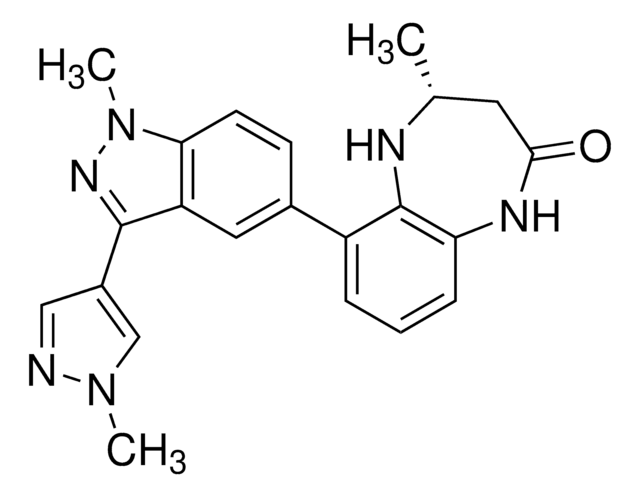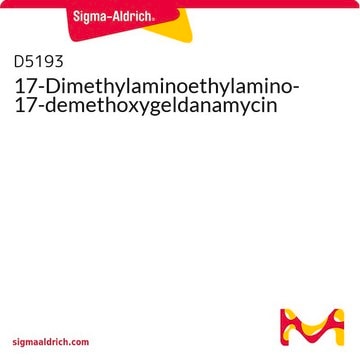A8476
17-(Allylamino)-17-demethoxygeldanamycin
≥98% (HPLC), solid
Synonym(s):
17-(Allylamino)geldanamycin, 17-AAG, 17-Demethoxy-17-allylamino geldanamycin, CP 127374, Geldanamycin,17-demethoxy-17-(2-propenylamino)-, NSC 330507, Tanespimycin
About This Item
Recommended Products
Quality Level
Assay
≥98% (HPLC)
form
solid
solubility
DMSO: soluble
methanol: soluble
antibiotic activity spectrum
neoplastics
Mode of action
enzyme | inhibits
shipped in
wet ice
storage temp.
−20°C
SMILES string
CO[C@H]1C[C@H](C)CC2=C(NCC=C)C(=O)C=C(NC(=O)\C(C)=C\C=C[C@H](OC)[C@@H](OC(N)=O)\C(C)=C\[C@H](C)[C@H]1O)C2=O
InChI
1S/C31H43N3O8/c1-8-12-33-26-21-13-17(2)14-25(41-7)27(36)19(4)15-20(5)29(42-31(32)39)24(40-6)11-9-10-18(3)30(38)34-22(28(21)37)16-23(26)35/h8-11,15-17,19,24-25,27,29,33,36H,1,12-14H2,2-7H3,(H2,32,39)(H,34,38)/b11-9-,18-10+,20-15+/t17-,19+,24+,25+,27-,29+/m1/s1
InChI key
AYUNIORJHRXIBJ-TXHRRWQRSA-N
Gene Information
human ... HSP90AA1(3320) , HSP90AB1(3326)
General description
Application
- to study its effects on hippocampal neurons
- to analyze its effects on yes-associated protein (YAP) phosphorylation in adenocarcinoma human alveolar basal epithelial cells and human breast epithelial cells
- to study its effects on lifespan extension and health in Caenorhabditis elegans
Biochem/physiol Actions
Features and Benefits
Storage Class Code
11 - Combustible Solids
WGK
WGK 3
Flash Point(F)
Not applicable
Flash Point(C)
Not applicable
Personal Protective Equipment
Certificates of Analysis (COA)
Search for Certificates of Analysis (COA) by entering the products Lot/Batch Number. Lot and Batch Numbers can be found on a product’s label following the words ‘Lot’ or ‘Batch’.
Already Own This Product?
Find documentation for the products that you have recently purchased in the Document Library.
Articles
Cell cycle phases (G1, S, G2, M) regulate cell growth, DNA replication, and division in proliferating cells.
Apoptosis regulation involves multiple pathways and molecules for cellular homeostasis.
Our team of scientists has experience in all areas of research including Life Science, Material Science, Chemical Synthesis, Chromatography, Analytical and many others.
Contact Technical Service








